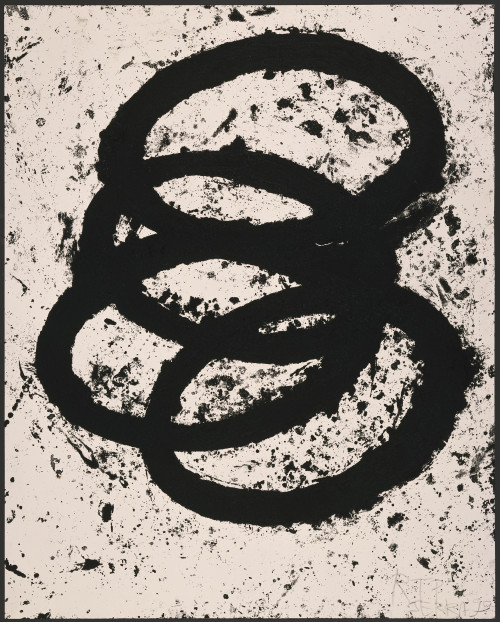
T.E. Siegen, 1998-99
Etching on Somerset Satin paper.
59.625 x 47.5 in (151.45 x 120.65 cm)
My mother began making jewelry as she was finishing her dissertation, just before I was born. She wanted to get out of the house, away from the typewriter, and create things with her hands. She’d always loved gold and precious gems, but had never wanted to pay exorbitantly high prices for high carat designer pieces. So, why not learn how to make the pieces she wanted?
The first gift of jewelry I remember receiving from her was a ring for my fifteenth birthday: a thick gold band she used to wear, newly set with one large, dark pink Burmese ruby in its center. Throughout my childhood, my mother had worn that gold band set with the diamond from her mother’s engagement ring. My mother inherited the diamond in 1979.
1979: my mother was a sophomore at Princeton, aged nineteen, straight brown hair and yellow, green eyes. Over Christmas break she was home, in New York City, but staying the night at her boyfriend’s house, when she got the call at 6 a.m. Her mother had committed suicide.
I’ve been aware for as long as I can remember that my grandmother took her own life. My parents chose never to hide it from me; they’ve answered all my questions. But my mother rarely tells stories about her, and there are no photographs of her around our house. So, while I’ve grown up knowing about her death, I know very little about her life.
Recently, I asked my mother why she had always worn her mother’s engagement diamond on her right hand, not her left. Wasn’t the diamond an engagement diamond? Why was she wearing her engagement ring on the wrong finger?
Wearing a diamond to symbolize engagement is a tradition deeply rooted in our culture, dating as far back as the 1840s. According to Sara Kohles in her short essay, “DIAMOND RINGS: Capitalizing on Social Trends,” the diamond ring first began to denote betrothal by providing the woman with a visible contract of her engagement This trend continued throughout the rest of the 1800s, into the beginning of the 20th century. Diamond rings became especially important around 1935, when states began eliminating the “breach of contract to marry” act. Also called the “breach of promise” or “heart balm” act, the “breach of contract to marry” act gave a ditched woman the right to sue her erstwhile fiancé for damages resulting from his breaking off the promised engagement. Without the legal protection of the eliminated act, Kohles writes that the diamond ring came to be “a natural form of collateral – as something valuable that a jilted bride could keep as compensation if her would-be husband absconded.” Essentially, the diamond ring provided the benefits of the “breach of contract to marry” act by ensuring that the woman would have some financial security were her fiancé to get cold feet.
Now that women do not need to rely on men for financial security (although a pay gap still exists: the Council of Economics Advisers Issue Brief cites in 2015 that women only earned 78 cents to every man’s dollar), the diamond ring is no longer a necessary pre-marriage convention. But a visit to Madison Avenue or a flip through a Tiffany’s catalogue will reveal how closely linked with engagement diamond rings still are. A November 2014 issue of Report on Business Magazine describes diamonds as being the “gem synonymous with love,” including the statistic that 8 out of 10 brides to be in the U.S. are still given a diamond ring as an engagement present.
But when I asked my mother why she didn’t wear her diamond ring on her left hand, as bridal tradition would indicate, she responded: “I wore it on my right hand because it’s not an engagement ring.”
The ring had been made for the occasion of my birth, she explained, seven years after she and my father were married; so that in becoming a mother herself, she could wear something of her mother’s. The diamond ring didn’t represent her marriage vow. It wasn’t a form of collateral or an announcement of coupledom. Its importance hadn’t come from her relationship with my father; the diamond itself was in no way connected to him: he neither owned it nor gave it. Instead, my mother wore the diamond to honor her own mother. The circumstances of her mother’s death complicated this memorial and my mother often speaks of the years following 1979 as years lost, years spent trying to stay afloat, stay functioning, hardly how we imagine living out college or our early twenties. It was hard for her not to feel that her mother had abandoned her, just on the cusp of adulthood. But years later, my mother ultimately desired to embrace her mother’s memory and give tribute to it, rather than reject it. To my mother, her diamond ring symbolizes the promises of motherhood and the connections of women.
On my fifteenth birthday, the diamond ring, made when I was born, was separated into two: my mother gave me the original ring’s band, now with a Burmese ruby, and made a new, more modern, setting for her mother’s diamond. It’s been only recently, as I too became a sophomore at Princeton, that I’ve realized the true meaning of the two rings: in my mother’s choice to separate the original ring and share it between us, she is including me in her life, in her history with her mother, in her loss.
I may not know much about my grandmother. I may never understand how her death has affected my mother. But I wear the ring my mother has made for me every day. And I know that every day my mother wears hers.